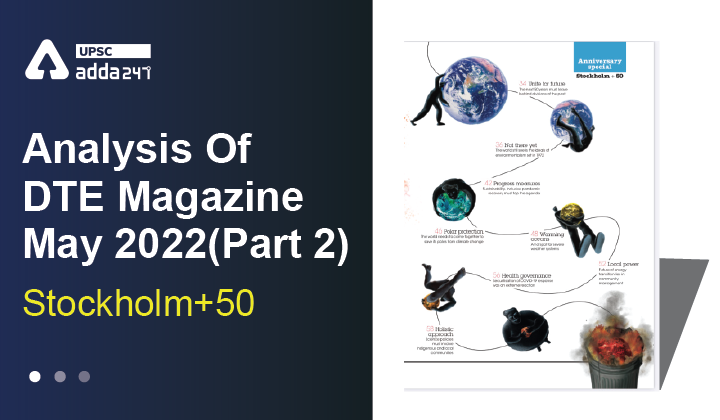Table of Contents
Stockholm+50
Introduction
The world is all tuned in to the Stock holm+50, to be held in the same city in June this year, but with a vastly changed planet, notwithstanding the rooting of the multi-lateral environmental regime.
What was UN Conference on the Human Environment in Stockholm?
- It was the first worldwide convergence on planetary environment, with the theme “Only One Earth”.
- The participating 122 countries—70 of them developing and poor countries—adopted the Stockholm Declaration on June 16, 1972.
- They essentially committed to 26 principles and an action plan that set in a multilateral environmental regime.
- This was the first globally subscribed document that recog- nised the “interconnections between development, poverty and the environment.”
- The three dimensions of this conference were: countries agreeing not to “harm each other’s environment or the areas beyond national jurisdiction”; an action plan to study the threat to Earth’s environment; and establishment of an international body called the UN Environment programme (unep) to bring in cooperation among countries.
Stockholm declaration
Key principles agreed to at the Stockholm conference, 1972 were:
- Earth’s natural resources, including air, water, land, flora and fauna, especially representative samples of natural ecosystems, must be safeguarded for the benefit of the present and future generations through careful planning or management.
- The discharge of toxic substances or of other substances and the release of heat, in such quantities or concentrations as to exceed the capacity of the environment to render them harmless, must be halted in order to ensure that serious or irreversible damage is not inflicted upon ecosystems. The just struggle of the peoples of ill countries against pollution should be supported.
- States shall take all steps to prevent pollution of the seas by substances that are liable to create hazards to human health, to harm living resources and marine life, to damage amenities or to interfere with other legitimate uses of the sea.
- The environmental policies of all States should enhance and not adversely affect the present or future development potential of developing countries, nor should they hamper the attainment of better living conditions for all, and appropriate steps should be taken by States and international organizations with a view to reaching agreement on meeting the possible national and international economic consequences resulting from the application of environmental measures.
- States have, in accordance with the Charter of the United Nations and the principles of international law, the sovereign right to exploit their own resources pursuant to their own environmental policies, and the responsibility to ensure that activities within their jurisdiction or control do not cause damage to the environment of other States or of areas beyond the limits of national jurisdiction.
STOCKHOLM 2022
- On June 2-3, world leaders will not discuss how the past half-century was, but how the next 50 years would be treated with emergency actions.
- It is also aptly themed as “Stockholm+50: A healthy planet for the prosperity of all – our responsibility, our opportunity.”
- If the Stockholm conference could accord some time to all, the current one comes without a deadline, as time has already run out.
Key Environmental Concerns Today
- Since the “environmental era” started, there are no signs of a restrain on our relationship with nature.
- As per UN data circulated as part of its Stockholm+50 commemoration, trade has gone up 10 times, the global economy by five times and the world population has doubled.
- Human development is largely fuelled by a tripling in the extraction of natural resources, food production, and energy pro- duction and consumption over the past 50 years.
- As per the unep’s “Inclusive Wealth Report 2018”, “During 1990-2014, produced capital grew at an average annual rate of 3.8%, while health and education induced human capital grew at 2.1%. Meanwhile, natural capital decreased at an annual rate of 0.7%.”
- The world is on track to warm at least 3 ̊Celsius above pre-industrial levels by 2100— despite a temporary decline in emissions due to the pandemic.
- That is double the 1.5 warming mandated in the Paris targets, which would require a 45% global emission reduction by 2030.
Conclusion
Where we are headed is a place we don’t want to go. So, the world need to fight with climate change on war footing without wasting a seconds time.



 TSPSC Group 1 Question Paper 2024, Downl...
TSPSC Group 1 Question Paper 2024, Downl...
 TSPSC Group 1 Answer key 2024 Out, Downl...
TSPSC Group 1 Answer key 2024 Out, Downl...
 UPSC Prelims 2024 Question Paper, Downlo...
UPSC Prelims 2024 Question Paper, Downlo...





